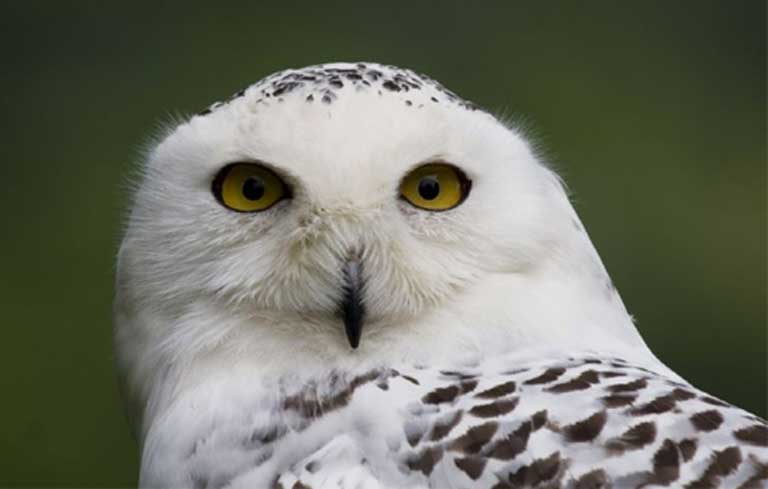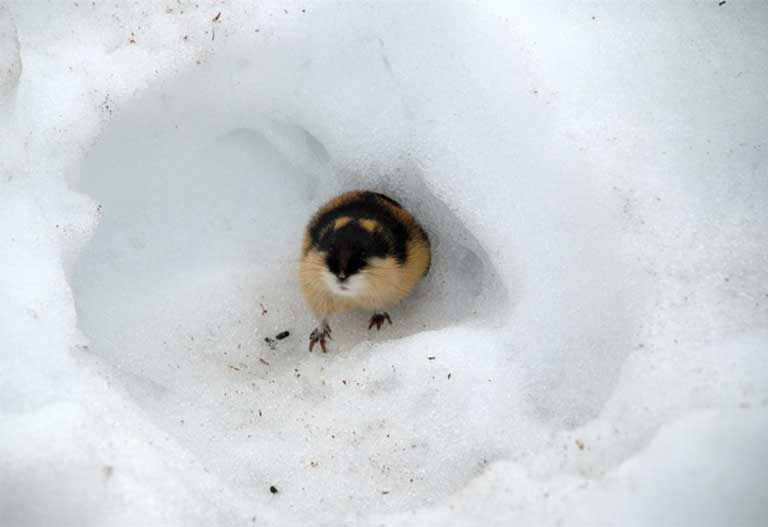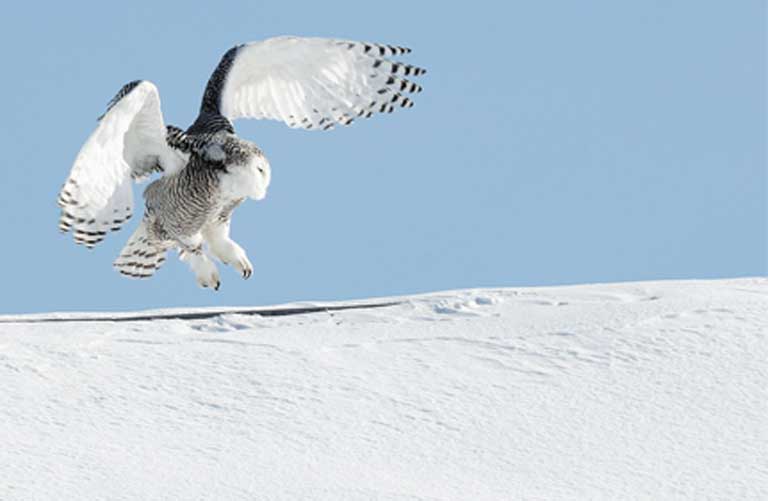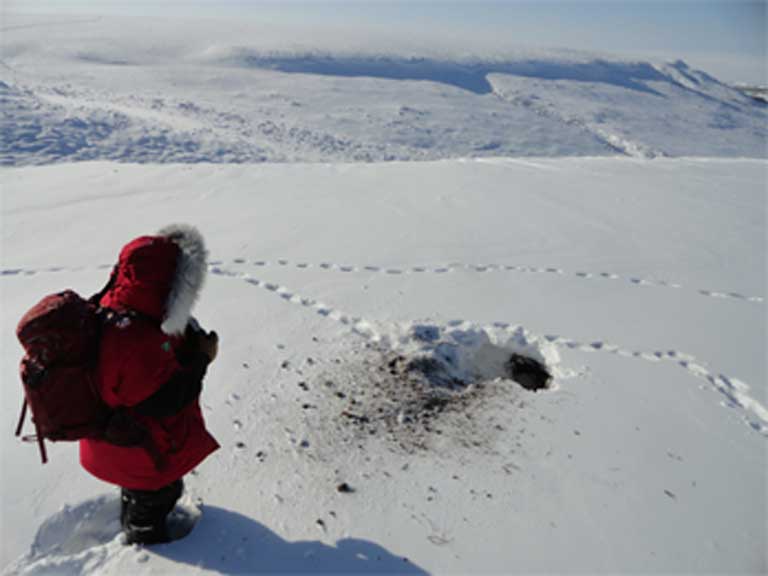- The media has long focused on the impacts of climate change on polar bears. But with Arctic temperatures rising fast (this winter saw the warmest October to February temperatures ever recorded), a wide range of Arctic fauna appears to be at risk, though more studies are needed to determine precise causes, current effects on population, and future projections.
- Diminishing Arctic snow, especially in the spring, may leave wolverines without ideal places to den. Caribou and reindeer populations have been in serious decline due to natural population fluctuation, but scientists don’t know if their numbers will recover under changed climate conditions.
- Lemmings are also being impacted by diminishing snow, often leaving the rodents without cover in spring and autumn. Their decline could impact the predators that prey on them, including Arctic foxes, red foxes, weasels, wolverines, and snowy and short-eared owls.
- Snowy owls have raised concerns because the seabirds they hunt in winter, which congregate around small holes in the Arctic ice, could become more widely dispersed in broader stretches of open water and therefore be harder to prey on. Scientists say more study of Arctic wildlife is urgently needed, but funding and media attention remains sparse.

In a changing Arctic, perhaps no story of a species in peril is more compelling than the plight of the polar bear. This forlorn, yet charismatic, Arctic refugee has been spending more time ashore in recent years as its sea ice habitat shrinks, forcing the bear to swim greater distances between ice floes while he wastes away in the search for blubbery pinnipeds to replenish lost calories.
But the polar bear, while iconic, is not alone in his struggles. The warming Arctic is impacting an array of species and not just those that share his waters. On land, climate change is redrawing the lines of species distribution, changing relationships between predator and prey, destroying den sites, and altering the timing of when plants bloom and when animals chow down. The driving mechanisms of such terrestrial transformation range from shrinking snow cover to rain-on-snow events that lock vegetation under ice; to boreal species moving northward and far more extreme weather.
Plants are already having to deal with the resulting stress. Unlike in the Arctic Ocean, where sea ice dictates the life cycle of species, on land what matters most is spring snow cover. Though climate change brings more winter snow, it’s also causing earlier snowmelt due to hotter temperatures which can dry out the fragile tundra too early each spring – before plants are able to suck up precious water.
In contrast, many northern animals seem to be benefiting from mellower weather, at least for the time being. But, the long-term forecast is grave. Increasingly, Arctic animals will come under pressure from boreal species moving up from the south, with earlier snowmelt clearing their path.
“Here in the High Arctic ecosystem, the areas farthest north are the most endangered,” says Hans Meltofte, the chief scientist of the Arctic Council’s 2013 Arctic Biodiversity Assessment. “Those species will be squeezed in between those encroaching from the south and the shores of the Arctic Ocean. They cannot move any farther north.”
And it’s those species that deserve to share in the polar bear’s spotlight.

Wolverines losing their homes?
Wolverines (Gulo gulo) are a wide-ranging species of mustelidae (think mink, weasels, and otters – but with a permanent snarl!). They seek out boulders and talus slopes for protection, food storage, and kit rearing in states like Washington and Oregon. But the Arctic is also host to its own population of this notorious carnivore, one of the most aggressive animals in North America. Up north, they’ve traded rock homes for snowy tundra abodes – and that makes them vulnerable.
Tom Glass, working with the Wildlife Conservation Society (WCS), is one of the few scientists studying the relationship between snow cover and wolverines in the field. Since 2016, he has been leading the first comprehensive ground-based collaring effort on Alaska’s North Slope, covering 500 square miles of tundra near the Umiat oil camp and 800 square miles around the Toolik Field Station. Wolverine distribution is strongly correlated with snow, and if the spring snow is melting sooner in the Arctic, Glass wonders how that will impact wolverines.
“There is a cadre of wildlife species that use snow caves, but which ones will be affected we don’t know yet,” he says.

His colleague, Martin Robards, the director of WCS’s Arctic Beringia Program, thinks wolverines may increasingly be limited by a need to build their dens where snow lingers longest and deepest in spring. “The snow landscape is no longer one where everything is equal. Now, some areas are really important if snow drifts there linger on into June.”
“I think there’s going to be a lot of ability for wolverines to adapt to this, but [we need to] think about where we can get some planning in ahead of time that will maintain the most critical habitats,” says Robards. Still, there’s lots of research needed to track global warming impacts.

Caribou and Reindeer population recoveries in trouble
How will climate change affect caribou and reindeer populations (Rangifer tarandus), synonymous with, and so important to, northern Indigenous societies? The jury is still out.
“It’s so complicated with these [climate] fluctuations that I don’t think anyone dare guess,” says the Arctic Council’s Meltofte.
What we do know about northern ungulates is this:
Caribou and reindeer herds fluctuate naturally in size, ballooning by millions, then dropping by just as much the next decade. Currently, wild reindeer and caribou have declined by about 33 percent since populations peaked in the 1990s and early 2000s – falling from 5.6 million to 3.8 million. This follows almost universal increases witnessed in the 1970s and 1980s.
Before climate change began escalating rapidly in the 21st century, herds always recovered. Now, with many populations across the tundra in sharp decline, it’s unknown if these ungulates are in a natural cycle and will bounce back, or if recovery may be delayed with some herds, while others could disappear altogether.
Scientists long believed that periodic icing – known as rain-on-snow events – of the winter ranges for reindeer and caribou led directly to mass starvation and could even extirpate local populations. With rain-on-snow events expected to become more frequent due to climate change, this seemed great cause for concern. But in 2016, a study by University of Tromso researcher N. J. C. Tyler found that there are few datasets that actually show ice-hardened snow was present on the ranges where populations are known to have declined or disappeared. Rather, winter warming and more snow were found to increase animal abundance.
Then there’s the impact of the loss of spring snow cover, which drives many Arctic animal life cycles. In Canada, caribou used to rest on deep snow banks, which provided refuge from hungry mosquitoes. But now, the Inuit have witnessed those snow banks disappearing, and “the caribou are more bothered by mosquitoes,” says Meltofte. Caribou attacked by large swarms of mosquitoes will flee, which means they spend less time eating, which could impact the animals’ health.
Changes in the reindeer and caribou food supply could also imperil these species. One concern is the encroachment from the south of the trees and shrubs, along with the disappearance of the ungulates’ preferred foods – grasses, lichens, and mosses. Another threat comes from a climate change-driven mismatch in the timing of when plants are ready to eat and the caribou’s breeding cycle, causing caribou to lose their calves. But as with wolverines, researchers need more time to suss out these relationships.

As lemmings go, so go their predators
If any animal can be considered the bedrock of the tundra ecosystem and food chain, it’s the lemming (Lemmus lemmus). These sleek, short-tailed, furry-footed rodents serve as an obligate snack for an enormous guild of the tundra’s predators – Arctic foxes, red foxes, weasels, wolverines, and snowy and short-eared owls. If the lemmings fall off the climate change cliff, then their predators could be at risk too.
And lemmings aren’t doing so hot.
For six months of the year, lemmings live in burrows deep in the insulating snow. Here, they breed and shelter from harsh winter conditions. But according to the 2013 Arctic Biodiversity Assessment, regional collapses of lemming populations are already occurring. For example, in Norway, populations usually peak every three to four years. However, the last peak was in 1994.
That’s likely because snowfall patterns have changed. Each year, the snow needs to be deep enough so that lemmings can stay warm without expending too much energy – energy required to breed and avoid predators out in the open. But snow is arriving later in autumn and melting earlier in the spring, leaving the lemming exposed. In some places, more compact snow with ice crusts has made it hard for lemmings to dig out their snow holes. Or there simply isn’t enough snow to begin with, so there’s fewer places in which the rodents can make their homes and lock up their food in the ice.
While the decline of the lemming is concerning in itself, scientists are worried about how its loss could jeopardize the Arctic food web; predator populations often fluctuate alongside lemming populations. Though some predator species may be able to diversify as southern rodent species move northward, others could lose out to southern predators coming up, too.
Red foxes, for instance, have already gained significant ground on Arctic foxes thanks to warmer temperatures boosting ground squirrel and bird populations which the red fox preys on. Arctic foxes, meanwhile, have continued to limit their diet to lemmings. How these north-south species collisions might play out in the long-run is currently unknown.

Snowy owls working harder for a meal
Snowy owls (Bubo scandiacus) are a migratory species, flying from the Arctic and sub-Arctic in the summer months, down to the prairies of Canada and the United States in the winter. Or so scientists thought.
In the late 2000s, during research conducted for the International Polar Year, scientists tracked a number of snowy owls and found that 78 percent of breeding adults they tracked actually stayed in the north in the winter and didn’t head south. Rather, they hunted seabirds among the Arctic Ocean sea ice.
“Many [snowy owls] become marine predators,” in the winter, says J. F. Therrien, a biologist at Pennsylvania’s Hawk Mountain Sanctuary who worked on the snowy owl study. In winter, the Arctic Sea is not totally covered by ice; there are open water patches created by tidal currents and wind. There, seabirds gather and the snowy owls feed.
But as climate change forces the sea ice to retreat, the seabirds could disperse into wider stretches of open water, with the prey becoming scattered rather than clustered tightly together around limited ice holes. Researchers believe that would mean less opportunity and more work for the owls.
If that’s the case, the snowy owl could be facing a double whammy. Not only will it have a harder time hunting seabirds, but snowy owls also feed on lemmings.
In 2017, the snowy owl was upgraded to Vulnerable on the IUCN Red List, though researchers are still figuring out the exact health of the global population.
“They seem to be adaptable birds because they have a very flexible migration strategy,” says Therrien. “There’s not a direct link with sea ice and snowy owl population status, but there sure is going to be an impact on the environment and some of the resources they’ve been using in the winter.”

Mountain Goats
Though the northernmost range of the mountain goat (Oreamnos americanus) cuts off at the sub-Arctic, the animal is a good example of the unique, unpredictable ways climate change can impact cold-adapted species.
“There’s a saying that under climate change, species have three options: adapt, move or die,” explains Kate Nowak, a freelance conservation scientist. But the outcome of those choices can be determined by a key factor: “Timing can be everything,” she says.
This summer, Nowak will travel to the Yukon, the upper northern limit of mountain goat range, to study the “molting chronology” of the animals. She’ll be looking at when the goats shed their thick hair as they experience hotter temperatures.
Mountain goats have two-layered coats that can be up to four-inches thick in the winter. Come spring, they shed those coats. Nowak wants to know if mountain goats are shedding earlier in response to global warming.
Though a sudden unseasonable snow storm could leave molted goats vulnerable, Nowak says the greater risk is heat stress to unmolted goats. If mountain goats don’t molt early enough to cope with hotter days brought climate change, or if they don’t adjust behavior by staying in shady or windy places, they could die.
Photogenic mountain goats offer a unique advantage to climate researchers. Though many species molt, including elk and moose, mountain goats are historically very well photographed by their human admirers, allowing scientists like Nowak to compare and contrast a half-century-worth of dated molting mountain goat images with current observations.
Other Arctic species molt, too – muskox, for example, lose their qiviut. Understanding the molting dynamics of mountain goats may help researchers better understand the risks posed to these even more northern species.

Arctic animals: canaries in the global warming coal mine
The greatest challenge Arctic researchers face today isn’t the region’s remoteness or inhospitability. Rather it is the lack of global interest – and money – flowing to the study of cold-acclimated wildlife.
Whatever the reason for that, researchers have long lamented that the tropical charismatic megafauna – elephants, rhinos, tigers – get the lion’s share of media and public attention, with polar bears and marine mammals bathing in what little limelight shines up into the polar night of the Arctic.
But as temperatures up north continue to rise at double the rate of the rest of the world, it makes sense to focus more climate change research funding in the region. Studying rapidly evolving Arctic habitat and wildlife impacts could provide a dramatic preview, and offer invaluable clues toward understanding shifting ecosystem dynamics due to global warming as they unfold around the planet.
FEEDBACK: Use this form to send a message to the author of this post. If you want to post a public comment, you can do that at the bottom of the page.

